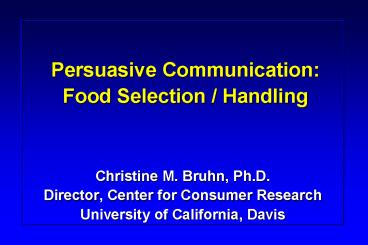Persuasive Communication: Food Selection / Handling - PowerPoint PPT Presentation
1 / 24
Title:
Persuasive Communication: Food Selection / Handling
Description:
animals' food and water. biosecurity, probiotics, and other 'Good Agricultural Practices' ... Food is like fresh. Considered safe by scientific community ... – PowerPoint PPT presentation
Number of Views:44
Avg rating:3.0/5.0
Title: Persuasive Communication: Food Selection / Handling
1
Persuasive Communication Food Selection /
Handling
- Christine M. Bruhn, Ph.D.
- Director, Center for Consumer Research
- University of California, Davis
2
Communication Goal
- Choice consistent with personal values
- Aware of science-based information relative to
risk and benefits
3
Communication A Two Way Process - Listen -
Understand Concerns - Assess knowledge -
Determine information sources - Develop /
Deliver Message - Evaluate Effectiveness
4
Three Examples
- General Audience
- Safe handling of produce
- At Highest Risk for Foodborne Illness
- Safe handling in general
- Controversial Topic
- Safety enhanced product
5
Consumer Handling of Fresh Fruits and Vegetables
Goals
- Identify consumer handling practices
- Evaluate effectiveness of washing method
- Develop scientific-based consumer handling
recommendations - Evaluate guidelines for consumer understanding
and usage
FDA Funded research project
6
Consumer Behavior Assessment
- Focus Groups current practices attitudes
- Mail Survey quantify information
- Nationwide, 2000 consumers
- Handling and washing questions
- Convenient information sources
- Demographics
- Focus Groups response to educational brochure
7
(No Transcript)
8
Distribution
- Cooperative Extension Offices
- On-line
- Master Gardeners
- Education Programs
- Referenced in media interviews
- Offered to Fight BAC
- Updated and Reprinted in 2008
9
- USDA
- Funded
- multistate
- Research
- project
2003
10
(No Transcript)
11
(No Transcript)
12
Distribution
- Available through Cooperative Extension
- Referenced in USDA Food Safety Educator
13
- Safe production includes activities at each stage
of production from farm to table
On-farm sanitation, safety of animals' food and
water biosecurity, probiotics, and other "Good
Agricultural Practices"
Production
Plant sanitation, quality control HACCP,
inspection and other "Good Manufacturing
Processes"
Processing
Pathogen killing step
Pasteurization, retort canning, irradiation
Final preparation and cooking
Consumer education, Foodhandler
certification, Restaurant inspection
14
Food Irradiation
- Exposes foods to measured levels of energy
- Can reduce microbes, replace fumigants, extend
shelf life - Food is like fresh
- Considered safe by scientific community
- Approved for meat, poultry and some other foods
- Under review for leafy greens and other foods
15
Organizations Opposing Food Irradiation
- Dangerous chemicals are formed
- Nutritional value is destroyed
- Will cover up filthy handling operations
- All people have to do is cook the product
16
- Food irradiation Potential annual public health
benefits by specific pathogen
Pathogen Preventedcases Prevented hospitalizations Prevented major complications Preventeddeaths
E. coli O157H7 and other STEC 23,000 700 250 HUS cases 20
Campylobacter 500,000 2,600 250 GBS cases 25
Salmonella 330,000 4,000 6,000 RA cases 140
Listeria 625 575 60 miscarriages 125
Toxoplasma 28,000 625 100-1,000 cases Cong. toxo 94
Total 881,625 8,500 6,660 major illnesses 352
R. Tauxe, CDC. 2001
17
Consumer Response
- When people hear science-based information about
irradiation - 60-99 will select irradiated meat/poultry
- When people only hear negative information
- 10-15 will select irradiated meat/poultry
- Parents with young children are least likely to
select irradiation protected meat/poultry - When negative information is countered, interest
in buying increases
Fox 2002 Bhumiratana, Belden and Bruhn 2007
18
Extending the Message
- Community meetings / Trainings
- Handouts
- Web messages / resources
- MEDIA
- Radio
- Newspaper / magazines
- Television
19
Evaluating Effectiveness
- Interest in educational material
- Reported behavior
- Observed behavior
- Changes in foodborne illness data
- Marketplace purchases
20
Practices Persons With HIV Will Follow
21
Barriers to Safe Handling
- Messages not heard by everyone
- Program funding is targeted to specific groups
and is short term - People must take the initiative and seek
information - People think they are already knowledgeable
- Time delay between unsafe behavior and getting
sick
22
Barriers to Safe Handling
- People dont follow recommendations
- Optimistic biases doesnt affect them
- Too busy
- Not convenience thermometer
- Not necessary
- Taste preferences
23
Food Safety Education Today
- Education focuses on 4 - 6 behaviors
- Guidelines are clear
- Recommendations are specific by age and health
condition - Messages are presented nationwide, but consumers
dont know all the specifics - People dont follow all the recommendations
- Education alone is not sufficient
24
Needs
- Sustained educational program
- Endorsement and encouragement by physicians,
health providers, and other trusted parties - Models of appropriate behavior
- Timely regulatory approval for innovative
technologies - Regulatory oversight of false or misleading claims































